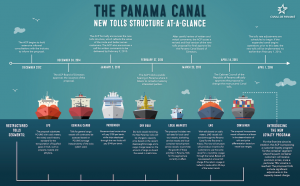Panama Canal to introduce revised toll structure next year
The Panama Canal Authority (PCA) has been given the go ahead by the government to modify the toll structure charged to vessels using the canal.
 From April 2016, a more bespoke system will apply charges according to the level of utilisation and cargo type along the majority of its segments. The PCA said the new charges would better facilitate service and reliability to the global shipping and maritime community while ensuring the competitiveness of the waterway.
From April 2016, a more bespoke system will apply charges according to the level of utilisation and cargo type along the majority of its segments. The PCA said the new charges would better facilitate service and reliability to the global shipping and maritime community while ensuring the competitiveness of the waterway.
The diverse freight moved through the canal will now be priced according to different units of measurement. The current static structure is based on the standard unit of measurement – the Panama Canal ton – and the gross tonnage of the vessel. From next year the charging structure will be based on the utilisation of the vessel combined with its deadweight and the weight of the cargo it is carrying. For vehicle carriers the use of weight and utilisation levels replaces the car equivalent unit (CEU) measurement that was applied variably according to the different operators.
“To incorporate a little more variability in the toll structure and flexibility for the customers we decided to keep the Panama Canal toll structure but we are adding utilisation levels,” explained Félix Ayarza, the PCA’s senior specialist in international commerce, Vehicle Carrier Segment, Executive Vice Presidency for Planning and Business Development. “Those utilisation levels are being based on weight because everyone has a different CEU measurement and we couldn’t get an agreement on what the CEU was for each ship.”
Ayarza said the new pricing structure would provide more flexibility for vehicle carriers that were increasingly diversifying their cargo.
“Most of the ships are PCTC (pure car/truck carrier) now but the companies are diversifying so they can carry different types of cargo, such as high and heavy equipment,” said Ayarza. “This type of flexibility is what we are trying to incorporate in the toll structure.”
Ayarza said the PCA will charge an empty ship rate to vessels that are up to 10% of utilisation based on weight of the cargo. From there the structure will apply competitive pricing for the deep-sea trade.
Another feature of the new toll structure is that it will not differentiate between ships using the existing locks or the new ones being built as part of the canal’s expansion to accommodate bigger vessels.
“If you see the order book for vessels now most of them are post-Panamax but they are carrying similar amounts to what they carry now,” noted Ayarza. “So what will happen is we will try to stabilise pricing not to impact them on the dimensions of the vessels but focus it on the capacity.”
Container ships will continue to be measured on price on standard containers (TEUs). The restructuring will be implemented alongside a customer loyalty programme for the container segment, which is a first for the PCA. Frequent container customers will not receive premium prices once a particular TEU volume is reached.
In addition, a new Intra Maritime Cluster segment has been created that includes local tourism vessels, marine bunkering and container transshipment vessels that do not compete with international trade.
"After working in close cooperation with our partners in the maritime industry, I am pleased we will be able to provide a more bespoke pricing solution for our customers; one that recognises their various needs and requests, while still appreciating the value and reliability provided by the route," said Panama Canal Administrator and CEO Jorge Quijano.
Read more about Panama’s plans for a ro-ro transhipment hub at Manzanillo International Terminal in the next edition of Finished Vehicle Logistics magazine.





